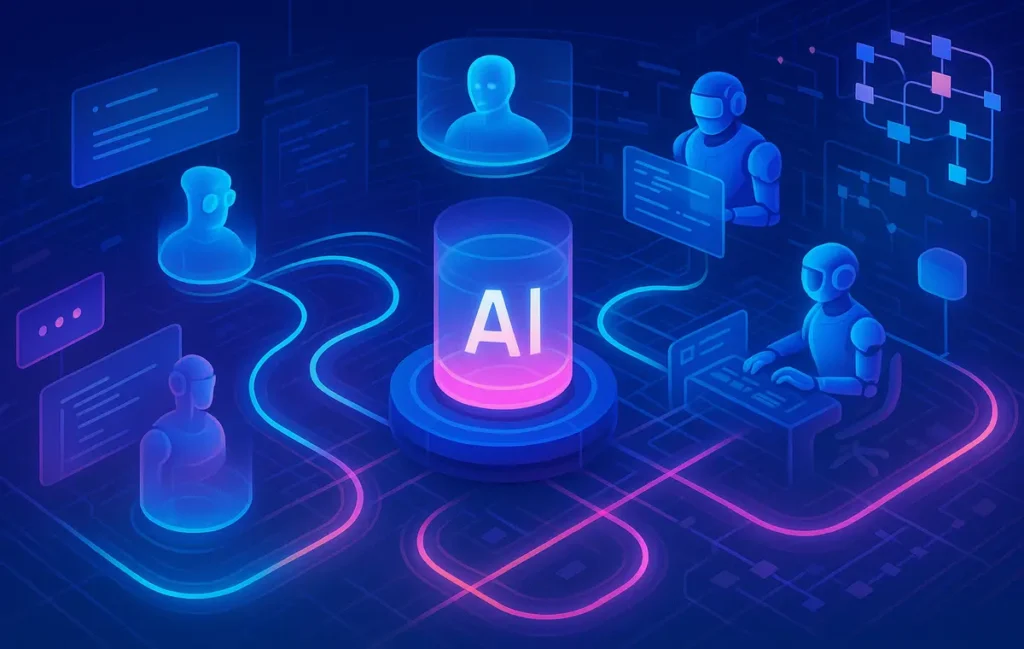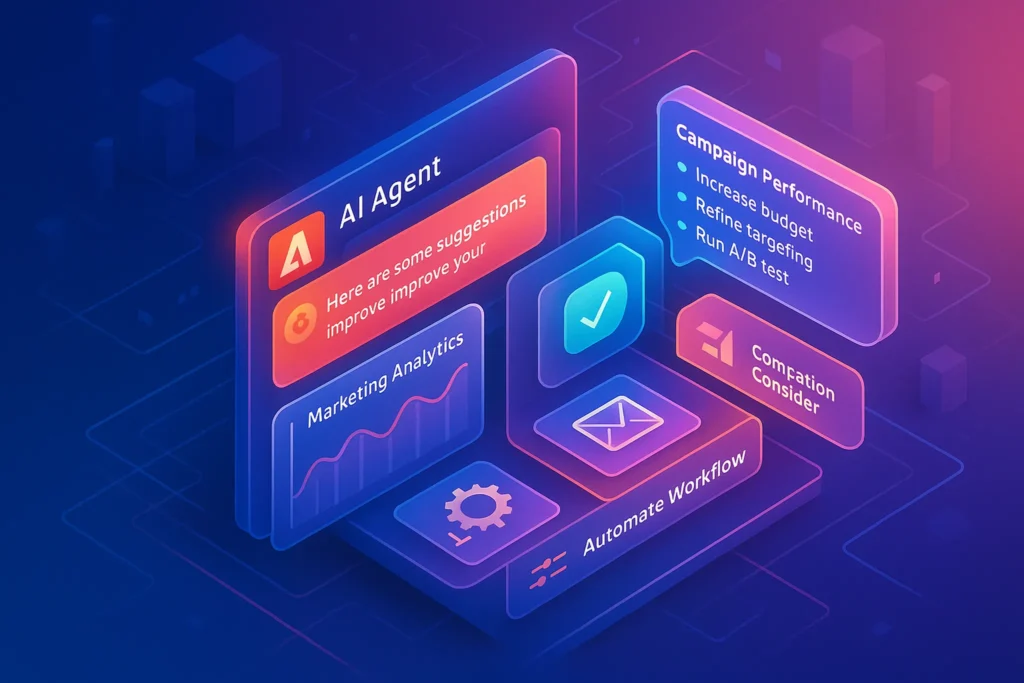🎯 Introduction: From Asking to Acting
For years, artificial intelligence was a question-and-answer machine. You typed a prompt, the model responded, and the interaction ended there. But 2025 has brought a different frontier: AI that doesn’t just answer—it executes complete workflows end to end.
This transformation is powered by agentic AI, a model of automation where autonomous loops can run without constant human prompting. Unlike the early days of prompt engineering, where every detail had to be manually crafted, agentic workflows now design, execute, and monitor themselves. They don’t just write an ad copy—they plan the campaign, launch the test, monitor performance, and iterate in real time.
If you’ve read our earlier explorations like Adobe AI Agents for Marketing or Top AI Agent Builders to Try, you’ve already seen the building blocks. But this post goes further: real use cases of how agentic AI is replacing linear prompting with autonomous loops that deliver measurable ROI.
💡 Nerd Tip: Think of this shift as moving from typing instructions into a computer, to hiring a digital colleague who knows the playbook and keeps improving without being asked.
🔍 From Prompts to Workflows: The Evolution
The journey of AI interaction has followed a clear arc:
At first, it was prompt-based. One input, one output. Users spent time tweaking wording to squeeze better answers. Prompt engineering became its own discipline.
Then came chained prompts. Instead of single outputs, prompts could be linked, creating small pipelines of tasks. This was the era where tools like Zapier scripts or GPT plug-ins turned AI into semi-structured helpers.
Next evolved semi-autonomous agents. These could run multiple steps with some predefined rules, but they still required supervision and frequent human intervention.
Now we are entering the era of full agentic loops. These loops can:
-
Accept a goal (“launch a product campaign in two weeks”)
-
Plan the steps across multiple apps and platforms
-
Execute with minimal oversight
-
Self-monitor for errors or dead ends
-
Exit when a condition is met
The difference between prompt engineering and workflow design is crucial here. Prompt engineering is tactical—it’s about phrasing the input. Workflow design is strategic—it’s about setting objectives, rules, and exit conditions so the system can operate sustainably.
As one user recently posted on X about LangChain: “Prompting got me a draft email. Agentic loops booked the meetings, sent the emails, and tracked replies automatically.”
That’s the paradigm shift businesses need to understand.
🛠️ Real Use Cases of Agentic AI Workflows
📢 Marketing Campaign Orchestration
Instead of writing copy manually, agentic AI can now map an entire campaign: generating multiple ad variations, A/B testing them, monitoring click-through rates, and shifting budget automatically. Unlike early automation tools, these agents don’t just follow static rules—they adapt. A retailer that used HARPA AI reported 15% higher ROI in campaign efficiency by letting the system rebalance ad spend on the fly.
For more tactical insights, see 7 Emerging AI Marketing Tools You’ve Never Tried—that article introduced individual apps, but what you’ll see here is how they interconnect in loops that keep running.
🤝 Customer Support Resolution
Chatbots were once reactive: they answered FAQs and escalated complex cases. Now, agentic loops can resolve tickets end to end. Imagine a customer reporting a failed payment: the agent checks the billing system, retries the charge, offers a discount code if needed, and updates the CRM. Human agents only step in when edge cases or compliance risks appear.
This doesn’t replace your support team—it augments them by clearing repetitive cases so humans can focus on empathy and strategy.
🔍 Research Agents and Fact-Checking
Prompt-based research could summarize a Wikipedia page. Agentic loops go further: scanning multiple sources, cross-checking for contradictions, tagging credibility scores, and compiling structured reports. A consultancy using CrewAI cut their prep time for industry briefings by 40%, while reducing error rates from hallucinations by building in verification loops.
📊 Business Intelligence Loops
Enterprises already run ETL pipelines (Extract, Transform, Load). By embedding agentic AI into the pipeline, these loops don’t just transform data—they analyze and generate insights automatically. A fintech firm tested this with LangChain and reported that weekly reporting tasks dropped from 12 hours of analyst time to under 90 minutes, with higher depth of analysis.
🗂️ Personal Productivity Agents
For individuals, agentic AI is redefining productivity stacks. A Notion workspace integrated with email and calendar can now auto-sort incoming tasks, flag priorities, and reschedule low-value meetings. If you enjoyed our guide on 5 AI-Powered Notion Templates to Automate Your Workflow, this is the natural next step: turning templates into self-running loops that learn from your daily habits.
💡 Nerd Tip: Every loop needs an exit condition. Without one, your agent risks getting stuck in a feedback cycle, repeating actions endlessly.
⚡ Tools Powering Agentic AI
Behind every loop are frameworks and platforms designed to manage complexity.
LangChain remains a foundation, enabling developers to chain together models, data, and APIs into coherent agents. AutoGPT and BabyAGI evolutions showed what was possible when agents could recursively call themselves. These projects were clunky at first, but they seeded the rise of smoother solutions.
Today, platforms like CrewAI and AgentOps make monitoring and debugging loops more manageable. Businesses prefer these because they provide dashboards and alerts when an agent misfires.
For no-code and SMB adoption, HARPA AI advanced workflows are becoming popular. Its approach blends web automation with agentic orchestration, lowering barriers to entry.
And in marketing, Adobe Agents for Marketing are already reshaping campaign execution by offering enterprise-grade creative automation that links with analytics suites.
If you want a comparison of core builders, check our earlier article Top AI Agent Builders to Try. That piece outlined the options—here, we’re focusing on how they’re deployed in production.
📈 ROI and Business Value
Agentic AI isn’t just a buzzword. It’s proving measurable gains in three areas:
First, labor cost reduction. Automating repetitive workflows means companies need fewer manual hours per project. A mid-sized SaaS company reduced their onboarding support team by 20% after deploying customer support loops.
Second, speed of execution. Loops can handle tasks in parallel without fatigue. In campaign testing, one agent can evaluate dozens of variations overnight, while a human team would need weeks.
Third, scalability. The same loop that runs for a small startup can scale with enterprise data volumes. This flexibility is why both SMBs and Fortune 500s are piloting agentic systems in parallel.
💡 Nerd Tip: Always measure ROI not just in cost saved, but in opportunity unlocked—faster launches, more campaigns tested, or insights that weren’t possible before.
🚀 Implementation Guide
Transitioning to agentic AI requires discipline.
Step 1: Identify repetitive workflows. Look for tasks that occur daily or weekly, such as reporting, email follow-ups, or ad optimizations.
Step 2: Map into agent tasks + triggers. Define inputs, expected outputs, and what triggers a loop. A clear map avoids scope creep.
Step 3: Select framework or tool. For developers, LangChain and AgentOps provide depth. For SMBs, HARPA AI is more plug-and-play.
Step 4: Run a controlled pilot. Limit the loop to a safe environment, monitor outputs, and adjust parameters.
Step 5: Scale to production with monitoring. Add dashboards, alerts, and human override conditions. Agentic AI is powerful, but like any employee, it needs checks and balances.
⚠️ Challenges and Solutions
Like any technology, agentic AI is not flawless.
Hallucination and error loops are a known risk. Agents sometimes misinterpret goals or fabricate information. Mitigation includes multi-source verification and limiting action scopes.
Integration complexity is another barrier. Plugging agents into legacy systems or CRMs requires middleware and careful testing.
And of course, ethical and compliance risks remain front of mind. Automated decisions in finance, healthcare, or HR must follow strict regulations. Transparent audit trails are essential.
💡 Nerd Tip: Treat agentic loops as teammates. You wouldn’t give a new hire unsupervised control of your bank accounts on day one—don’t give your AI loops blind trust either.
⚡ Ready to Build Smarter Workflows?
Explore AI workflow builders like HARPA AI, LangChain, and AgentOps. Start small, experiment, and grow your first autonomous loop this week.
🕰️ Historical Context: The Road to Agentic AI
Agentic AI didn’t appear overnight. It’s the result of a long technological arc. Back in the 1980s, businesses experimented with rule-based expert systems—rigid programs that could mimic decision-making if-then rules. They were powerful for narrow tasks but brittle when facing exceptions.
The 2000s ushered in machine learning, where models learned patterns from data rather than relying solely on rules. This was followed by the deep learning boom in the 2010s, where neural networks drove breakthroughs in vision, language, and speech.
By 2020, large language models like GPT had arrived, democratizing AI by making natural language a universal interface. Suddenly, prompting was enough to unlock powerful outputs. But prompting alone was limited—it lacked continuity, memory, and execution capabilities.
The natural next step is what we now call agentic AI: systems that not only generate answers but design, monitor, and complete entire workflows. Just as machine learning replaced rules, and LLMs replaced static models, agentic loops are now replacing prompt-by-prompt micromanagement.
💡 Nerd Tip: Looking at AI as a 40-year timeline helps remind us—this isn’t hype. It’s the next logical step in automation history.
❌ Failure Case Studies: When Loops Go Wrong
As powerful as agentic workflows are, failures highlight their risks.
In 2024, a fintech startup tested an autonomous trading agent. The loop was designed to analyze market signals and place small trades automatically. But a poorly defined exit condition caused the agent to keep doubling down on losing positions. Within a week, the system had burned through $120,000 in losses before humans intervened. The lesson? Guardrails and manual overrides are non-negotiable.
Another case comes from research workflows. A publishing house used an AI research agent to compile fact sheets for upcoming reports. The agent scanned dozens of sources but included a fabricated statistic because the verification loop wasn’t robust. The error made it into a published report, leading to an embarrassing retraction.
These examples underline a key truth: autonomy without accountability is dangerous. Just as new employees are onboarded with supervision, agentic AI loops require structured monitoring before full trust.
⚖️ Comparison Layer: Prompting vs Agentic AI
Here’s a structured look at how traditional prompting differs from agentic workflows:
| Aspect | Prompt-Based AI | Agentic AI Loops |
|---|---|---|
| Input | A single prompt or instruction | A goal or outcome definition |
| Process | One-off text generation | Multi-step planning, execution, and monitoring |
| Memory | Limited to one interaction | Persistent, can recall past actions |
| Error Handling | Requires human correction | Includes self-correction and exit conditions |
| Output | Draft content, answer, or suggestion | Completed workflows, executed tasks, measurable results |
💡 Nerd Tip: Prompts get you “answers.” Loops get you “outcomes.”
🏭 Industry-Specific Insights
Agentic AI is already creeping into specialized sectors:
Healthcare. Hospitals are experimenting with care management agents. A diabetes monitoring loop, for instance, analyzes patient glucose logs, suggests adjustments, and notifies clinicians if risks appear. The challenge is compliance—regulators require every loop to be auditable.
Finance. Banks are piloting fraud-detection loops that constantly scan transactions, cross-reference them with known fraud patterns, and freeze accounts in real time if anomalies appear. These loops reduce false positives compared to older systems, but again, human auditors remain essential.
E-commerce. Online retailers are testing dynamic pricing loops. An AI agent checks competitor prices, inventory levels, and demand signals, adjusting prices every few minutes. In one pilot, an e-commerce company improved profit margins by 6% while maintaining competitive pricing.
Education. Universities are deploying research assistants that summarize literature, draft teaching material, and even generate quiz banks, freeing up academics for higher-value work.
This industry layer shows that agentic AI isn’t theoretical—it’s happening across critical domains, from life-saving care to online shopping.
📊 Benchmarks and Numbers
Numbers give reality to the hype. Some benchmarks from pilots and case studies include:
-
A SaaS company that automated onboarding support saw a 20% reduction in support costs and faster resolution times.
-
Marketing teams using agentic loops for ad optimization reported CTR improvements of 12–18% over static campaigns.
-
A consultancy leveraging CrewAI for research loops cut report prep time by 40%, with a 25% reduction in factual inaccuracies compared to prompt-only workflows.
-
Productivity agents integrated into Notion and email reduced time spent on task organization by 30–35%, according to surveys of early adopters.
💡 Nerd Tip: Don’t just focus on cost savings—agentic AI’s hidden value lies in speed, scalability, and new possibilities that humans alone couldn’t deliver.
🔮 Future Outlook & Ethical Debate
The next frontier isn’t just single loops—it’s multi-agent ecosystems. Imagine a marketing agent collaborating with a research agent and a finance agent, coordinating seamlessly like a digital team. These ecosystems will eventually rival human departments in scope and efficiency.
But with great autonomy comes great responsibility. Who is accountable if an AI loop makes a harmful decision? If a healthcare agent misses a diagnosis or a finance agent flags the wrong account, the consequences are real. Regulators are already beginning to debate whether agentic AI should be classified as a “digital entity” with liability frameworks.
The ethical conversation will shape adoption. Will businesses deploy loops at scale before laws catch up, or will compliance bottlenecks slow progress? Either way, the genie is out of the bottle—agentic AI is here to stay.
💡 Nerd Tip: The most future-ready companies won’t just experiment with loops—they’ll also build governance systems around them.
📬 Want More Smart AI Tips Like This?
Join our free newsletter and get weekly insights on AI tools, no-code apps, and future tech—delivered straight to your inbox. No fluff. Just high-quality content for creators, founders, and future builders.
🔐 100% privacy. No noise. Just value-packed content tips from NerdChips.
🧠 Nerd Verdict
Agentic AI is not just another step in the AI hype cycle. It is the shift from response to execution. Businesses that embrace loops early will enjoy compounding advantages: faster campaigns, deeper insights, and streamlined operations.
At NerdChips, our perspective is clear: the companies building real agentic workflows today will be the market leaders of tomorrow.
❓ FAQ: Nerds Ask, We Answer
💬 Would You Bite?
Would you trust an AI agent to run parts of your daily workflow—without you watching over its shoulder?
Or would you rather keep full control, prompt by prompt? 👇
Crafted by NerdChips for creators and teams who want their best ideas to travel the world.



